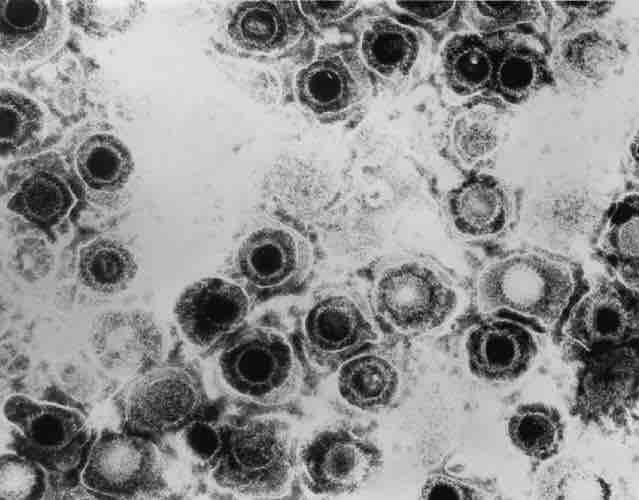Herpes genitalis (or genital herpes) refers to a genital infection by Herpes simplex virus . Following the classification HSV into two distinct categories of HSV-1 and HSV-2 in the 1960s, it was established that "HSV-2 was below the waist, HSV-1 was above the waist".

Transmission electron micrograph of herpes simplex virus.
TEM micrograph of a herpes simplex virus.
Although genital herpes is largely believed to be caused by HSV-2, genital HSV-1 infections are increasing and now exceed 50% in certain populations, and that rule of thumb no longer applies. HSV is believed to be asymptomatic in the majority of cases, thus aiding contagion and hindering containment. When symptomatic, the typical manifestation of a primary HSV-1 or HSV-2 genital infection is clusters of genital sores consisting of inflamed papules and vesicles on the outer surface of the genitals, resembling cold sores. These usually appear 4–7 days after sexual exposure to HSV for the first time. Genital HSV-1 infection recurs at rate of about one sixth of that of genital HSV-2.
In males, the lesions occur on the glans penis, shaft of the penis or other parts of the genital region, on the inner thigh, buttocks, or anus. In females, lesions appear on or near the pubis, labia, clitoris, vulva, buttocks or anus. Other common symptoms include pain, itching, and burning. Less frequent, yet still common, symptoms include discharge from the penis or vagina, fever, headache, muscle pain (myalgia), swollen and enlarged lymph nodes and malaise. Women often experience additional symptoms that include painful urination (dysuria) and cervicitis. Herpetic proctitis (inflammation of the anus and rectum) is common for individuals participating in anal intercourse.After 2–3 weeks, existing lesions progress into ulcers and then crust and heal, although lesions on mucosal surfaces may never form crusts. In rare cases, involvement of the sacral region of the spinal cord can cause acute urinary retention and one-sided symptoms and signs of myeloradiculitis (a combination of myelitis and radiculitis): pain, sensory loss, abnormal sensations (paresthesia) and rash. Historically this has been termed Elsberg syndrome, although this entity is not clearly defined.
Treatment
Medical research has not been able to find a way to halt the spread of herpes and the number of infected people keeps growing. In the United States alone, 45 million people are infected, with an additional one million new infections occurring every year. Presently, genital herpes cannot be cured. Moreover, genital herpes can be transmitted by viral shedding prior to and following the visual signs of symptoms. There are however some drugs that can shorten outbreaks and make them less severe or even stop them from happening.
Among these drugs are: acyclovir, valacyclovir and famciclovir.Acyclovir is an antiviral drug used against herpes viruses, varicella-zoster, and Epstein-Barr Viruses. This drug reduces the pain and the number of lesions in the initial case of genital herpes. Furthermore, it decreases the frequency and severity of recurrent infections. It comes in capsules, tablets, suspension, injection, powder for injection, and ointment. The ointment is used topically and it decreases pain, reduces healing time, and limits the spread of the infection.Valacyclovir is also used to treat herpes virus infections. Once in the body, it becomes the anti-herpes medicine, acyclovir. It helps relieve the pain and discomfort and the sores heal faster. It only comes in caplets and its advantage is that it has a longer duration of action than acyclovir. Famciclovir is another antiviral drug that belongs to the same class of acyclovir and valacyclovir. Famciclovir is a prodrug that is converted to penciclovir in the body. The latter is the one active against the viruses. This drug has a longer duration of action than acyclovir and it only comes in tablets.